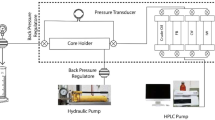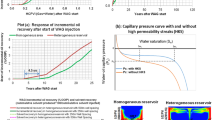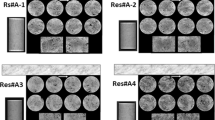Abstract
In this study, we systematically investigate the effect of core-scale heterogeneity on the performance of miscible CO2 flooding under various injection modes (secondary and tertiary). Manufactured heterogeneous core plugs are used to simulate vertical and horizontal heterogeneity that may be present in a reservoir. A sample with vertical heterogeneity (i.e. a layered sample) is constructed using two axially cut half plugs each with a distinctly different permeability value. In these samples, the permeability ratio (PR) defines the ratio between the permeabilities of adjacent half plugs. Horizontal heterogeneity (i.e. a composite sample) is introduced by stacking two or three short cylindrical core segments each with a different permeability value. Our special sample construction techniques have also enabled us to investigate the effect of permeability ratio and crossflow in layered samples and axial arrangement of core segments in composite samples on the ultimate recovery of the floods. Core flooding experiments are conducted with an n-Decane–brine–CO2 system at a pore pressure of 17.2 MPa and a temperature of 343 K. At this temperature, the minimum miscibility pressure of CO2 with n-Decane is 12.6–12.7 MPa so it is expected that at 17.2 MPa CO2 is fully miscible with n-Decane. The results obtained for both the composite and layered samples indicate that CO2 injection would achieve the highest recovery factor (RF) when performed under the secondary mode (e.g. layered: 79.00%, composite: 89.83%) compared with the tertiary mode (e.g. layered: 73.2%, composite: 86.2%). This may be attributed to the effect of water shielding which impedes the access of the injected CO2 to the residual oil under the tertiary injection mode. It is also found that the oil recovery from a layered sample decreases noticeably with an increase in the PR as higher PR makes the displacement more uneven due to CO2 channelling. The RFs of 93.4, 87.89, 77.9 and 69.8% correspond to PRs of 1, 2.5, 5, and 12.5, respectively. In addition, for the layered samples, crossflow was found to have an important role during the recovery process; however, due to excessive channelling, this effect tends to diminish as PR increases. Compared with the layered heterogeneity, the effect of composite heterogeneity on the RF seems to be very subtle as the RF is found to be almost independent from the permeability sequence along the length of a composite sample. This outcome may have been caused by the small diameter of the plugs resulting in invariable 1-D floods.








Similar content being viewed by others
References
Al Sulaiman, A.A., Krinis, D., Hossain, M.E.: Assessment of capillary pressure heterogeneity to optimize oil recovery and development cost of carbon dioxide floods. Society of Petroleum Engineers (2016)
Al Wahaibi, Y.M., Al Hadhrami, A.K.: First-contact-miscible, vaporizing- and condensing-gas drive processes in a channeling heterogeneity system. Society of Petroleum Engineers (2011)
Al-Bayati, D., et al.: An experimental investigation of immiscible CO2 flooding efficiency in sandstone reservoirs: influence of permeability heterogeneity. In: SPE Europec Featured at 80th EAGE Conference and Exhibition. Society of Petroleum Engineers, Copenhagen (2018)
Almehaideb, R.A., Shedid, S.A., Zekri, A.Y.: Laboratory study of miscible carbon dioxide flooding of UAE carbonate oil reservoirs. Society of Petroleum Engineers (2008)
Alvarado, V., Manrique, E.: Enhanced oil recovery: an update review. Energies 3(9), 1529–1575 (2010)
Bahralolom, I.M., Bretz, R.E., Orr Jr., F.M.: Experimental investigation of the interaction of phase behavior with microscopic heterogeneity in a CO2 flood. Soc. Pet. Eng. J. 3, 662–672 (1988)
Bikkina, P., et al.: Influence of wettability and permeability heterogeneity on miscible CO2 flooding efficiency. Fuel 166, 219–226 (2016)
Burger, J.E., Mohanty, K.K.: Mass transfer from bypassed zones during gas injection. Soc. Pet. Eng. J. 12, 124–130 (1997)
Chaouche, M., et al.: Capillary effects in immiscible flows in heterogeneous porous media. EPL (Europhys. Lett.) 21(1), 19 (1993)
Chopra, A.: Reservoir descriptions via pulse testing: a technology evaluation. In: International Meeting on Petroleum Engineering. Society of Petroleum Engineers (1988)
Cooney, G., et al.: Evaluating the climate benefits of CO2-enhanced oil recovery using life cycle analysis. Environ. Sci. Technol. 49(12), 7491–7500 (2015)
Dindoruk, B., Firoozabadi, A.: Crossflow in fractured/layered media incorporating gravity, viscous, and phase behavior effects: part I-formulation and features in layered media. SPE J. 2(02), 120–135 (1997)
Ding, M., et al.: Extraction and its effects on crude oil properties during CO2 flooding. Energy Sources Part A Recovery Util. Environ. Eff. 35(23), 2233–2241 (2013)
Ding, M., et al.: Oil recovery from a CO2 injection in heterogeneous reservoirs: the influence of permeability heterogeneity, CO2–oil miscibility and injection pattern. J. Nat. Gas Sci. Eng. 44, 140–149 (2017)
Donaldson, E.C., et al.: Enhanced Oil Recovery. I. Fundamentals and Analysis. Elsevier, Amsterdam (1985)
Enick, R.M., et al.: Mobility and conformance control for CO2 EOR via thickeners, foams, and gels—a literature review of 40 years of research and pilot tests. In: SPE Improved Oil Recovery Symposium. Society of Petroleum Engineers (2012)
Fayers, F.J., Lee, S.-T.: Crossflow mechanisms by gas drive in heterogeneous reservoirs. Society of Petroleum Engineers (1992)
Fernø, M.A., et al.: Parametric study of oil recovery during CO2 injections in fractured chalk: influence of fracture permeability, diffusion length and water saturation. J. Nat. Gas Sci. Eng. 27, Part 2, 1063–1073 (2015)
Georgiadis, A., et al.: Interfacial tension measurements and modelling of (carbon dioxide + n-alkane) and (carbon dioxide + water) binary mixtures at elevated pressures and temperatures. J. Supercrit. Fluids 55(2), 743–754 (2010)
Ghedan, S.G.: Global laboratory experience of CO2-EOR flooding. Society of Petroleum Engineers (2009)
Grigg, R.B., Schechter, D.S.: State of the industry in CO2 floods. Society of Petroleum Engineers (1997)
He, L., et al.: Potential evaluation of CO2 EOR and sequestration in Yanchang oilfield. J. Energy Inst. 89(2), 215–221 (2016)
Holm, L.: Carbon dioxide solvent flooding for increased oil recovery. SPE 216, 225–231 (1959)
Holm, L., Josendal, V.: Mechanisms of oil displacement by carbon dioxide. J. Pet. Technol. 26(12), 1427–1438 (1974)
Jarrell, P., et al.: Practical Aspects of CO2 Flooding. SPE Monograph, vol. 22. Society of Petroleum Engineers, Richardson (2002)
Jiménez-Martínez, J., et al.: Mixing in a three-phase system: enhanced production of oil-wet reservoirs by CO2 injection. Geophys. Res. Lett. 43(1), 196–205 (2016)
Kamali, F., Hussain, F., Cinar, Y.: An experimental and numerical analysis of water-alternating-gas and simultaneous-water-and-gas displacements for carbon dioxide enhanced oil recovery and storage. SPE J. 20, 227–237 (2016)
Khosravi, M., et al.: Mechanistic investigation of bypassed-oil recovery during CO2 injection in matrix and fracture. Fuel 117, Part A, 43–49 (2014)
Krause, M.H., Perrin, J.-C., Benson, S.M.: Modeling permeability distributions in a sandstone core for history matching coreflood experiments. SPE J. 16(04), 768–777 (2011)
Kulkarni, M.M., Rao, D.N.: Experimental investigation of miscible secondary gas injection. Society of Petroleum Engineers (2005)
Lake, W.: Enhanced Oil Recovery. Prentice Hall, Englewood Cliffs (1989)
Lake, L., Jensen, J.: A review of heterogeneity measures used in reservoir characterization. SPE (1989)
Langaas, K., Ekrann, S., Ebeltoft, E.: A criterion for ordering individuals in a composite core. J. Pet. Sci. Eng. 19(1), 21–32 (1998)
Li, F., et al.: An improved method to study CO2–oil relative permeability under miscible conditions. J. Pet. Explor. Prod. Technol. 5(1), 45–53 (2015)
Nobakht, M., Moghadam, S., Gu, Y.: Mutual interactions between crude oil and CO2 under different pressures. Fluid Phase Equilib. 265(1), 94–103 (2008)
Pande, K.K., Orr Jr., F.M.: Effect of viscous crossflow on miscibility development in a two-layer flow system: part I—ternary vaporizing gas drives. Soc. Pet. Eng. Adv. Technol. Ser. 2, 7–17 (1994)
Pini, R., Krevor, S.C.M., Benson, S.M.: Capillary pressure and heterogeneity for the CO2/water system in sandstone rocks at reservoir conditions. Adv. Water Resour. 38, 48–59 (2012)
Pini, R., et al.: Capillary heterogeneity in sandstone rocks during CO2/water core-flooding experiments. Energy Procedia 37, 5473–5479 (2013)
Rapoport, L., Leas, W.: Properties of linear waterfloods. J. Pet. Technol. 5(05), 139–148 (1953)
Saeedi, A.: Experimental Study of Multiphase Flow in Porous Media During CO2 Geo-Sequestration Processes. Springer, Berlin (2012)
Saeedi, A., et al.: Multiphase flow behaviour during CO2 geo-sequestration: emphasis on the effect of cyclic CO2–brine flooding. J. Petrol. Sci. Eng. 79(3–4), 65–85 (2011)
Shaver, R., Robinson, R., Gasem, K.: An automated apparatus for equilibrium phase compositions, densities, and interfacial tensions: data for carbon dioxide + decane. Fluid Phase Equilib. 179(1), 43–66 (2001)
Shedid, S.: Influences of different modes of reservoir heterogeneity on performance and oil recovery of carbon dioxide miscible flooding. J. Can. Pet. Technol. 48(02), 29–36 (2009)
Sohrabi, M., et al.: Mechanisms of oil recovery by carbonated water injection. In: SCA Annual Meeting (2009)
Stalkup, F.I.: Miscible Displacement. SIAM, Philadelphia (1983)
Tiffin, D., Yellig, W.: Effects of mobile water on multiple-contact miscible gas displacements. Soc. Pet. Eng. J. 23(03), 447–455 (1983)
Trivedi, J., Babadali, T.: Optimal injection strategies for CO2 and flue gas sequestration during tertiary oil recovery. Oil Gas Eur. Mag. 33, 22–26 (2006)
Tunio, S.Q., et al.: Comparison of different enhanced oil recovery techniques for better oil productivity. Int. J. Appl. Sci. Technol. 1(5), 143–153 (2011)
Whorton, L.P., Kieschnick, W.F.: A Preliminary Report on Oil Recovery by High-Pressure Gas Injection. American Petroleum Institute, Washington (1950)
Whorton, L.P., Brownscombe, E.R., Dyes, A.B.: Method for producing oil by means of carbon dioxide, U.s.p. office, editor (1952)
Yongmao, H., et al.: Laboratory investigation of CO2 flooding. Society of Petroleum Engineers (2004)
Zapata, V.J., Lake, L.W.: A theoretical analysis of viscous crossflow. Society of Petroleum Engineers (1981)
Zekri, A.R.Y., Shedid, S.A., Almehaideb, R.A.: Experimental investigations of variations in petrophysical rock properties due to carbon dioxide flooding in oil heterogeneous low permeability carbonate reservoirs. J. Pet. Explor. Prod. Technol. 3(4), 265–277 (2013)
Zhao, D.F., Liao, X.W., Yin, D.D.: Evaluation of CO2 enhanced oil recovery and sequestration potential in low permeability reservoirs, Yanchang Oilfield, China. J. Energy Inst. 87(4), 306–313 (2014)
Zhao, F., et al.: CO2 mobility control and sweep efficiency improvement using starch gel or ethylenediamine in ultra-low permeability oil layers with different types of heterogeneity. J. Pet. Sci. Eng. 133, 52–65 (2015)
Zhou, X., et al.: Novel insights into IOR/EOR by seawater and supercritical CO2 miscible flooding using dual carbonate cores at reservoir conditions. Saudi Aramco J. Technol. (2015)
Author information
Authors and Affiliations
Corresponding author
Rights and permissions
About this article
Cite this article
Al-Bayati, D., Saeedi, A., Xie, Q. et al. Influence of Permeability Heterogeneity on Miscible CO2 Flooding Efficiency in Sandstone Reservoirs: An Experimental Investigation. Transp Porous Med 125, 341–356 (2018). https://doi.org/10.1007/s11242-018-1121-3
Received:
Accepted:
Published:
Issue Date:
DOI: https://doi.org/10.1007/s11242-018-1121-3




